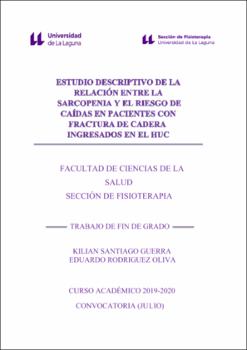Estudio descriptivo de la relación entre la sarcopenia y el riesgo de ca´ídas en pacientes con fractura de cadera ingresados en el HUC
Date
2020Abstract
Introducción: La sarcopenia es un trastorno del sistema músculo-esquelético que se
caracteriza por una masa muscular y una función muscular reducida, que genera un estado
de pérdida de rendimiento físico. Es una patología cada vez más frecuente en ancianos, y
que afecta a las actividades de la vida diaria del individuo, se relaciona con un alto riesgo
de caídas y una alta probabilidad de fracturas de cadera. Método: Diseño: Estudio piloto
observacional descriptivo, transversal, prospectivo sin grupo control, cuyo objetivo es:
establecer relaciones entre el riesgo de sufrir sarcopenia, con el riesgo de caídas en pacientes
que hayan sufrido una fractura de cadera por esta causa. Localización: pacientes ingresados
en la planta de Traumatología Ortopédica del CHUC en el periodo de 6 meses. Criterios de
inclusión y exclusión: Se incluirán pacientes con fractura de cadera de 65 años o más y con
consentimiento informado firmado y serán excluidos pacientes con deterioro cognitivo,
mayores de 90 años, cáncer en los últimos 5 años y trastornos metabólicos asociados.
Variables a estudiar serán como independientes el riesgo de sufrir sarcopenia según
cuestionario SARC-F y como dependiente principal cuestionario de riesgo de caída
Downton. Estudio estadístico, se realizará un estudio descriptivo de las variables se
calcularán frecuencias absolutas y relativas, Medias (M), mediana (mdn) y moda, varianza,
desviaciones típicas y coeficientes de variación. Para las variables cualitativas utilizaremos
Chi-cuadrado, para las variables cuantitativas, la prueba de correlación de Pearson. El
tratamiento de los datos se realizará con el paquete estadístico SPSS v.24.0 (Statistical
Package for the Social Sciences). Introduction: Sarcopenia is a musculoskeletal disorder characterized by muscle mass and
reduced muscle function, that generates a state of physical performance loss. It is an
increasingly common pathology in the elderly, and that affects the activities of the daily life
of the individual, is related to a high risk of falls and a high probability of hip fracture.
Methods: Design: Pilot, Descriptive, cross-cutting, prospective, observational study without
group control, whose objective is: establish relationships between the risk of sarcopenia,
with the risk of falls in patients who have suffered a hip fracture from this cause. Location:
patients admitted to the CHUC Orthopedic Traumatology plant in the 6-month period.
Inclusion and exclusion criteria: Patients with a hip fracture of 65 years or older and with
signed informed consent will be included and patients with cognitive impairment, over 90
years of age, cancer in the last 5 years and associated metabolic disorders will be excluded.
Variables to be studied will be the risk of sarcopenia as independent according to SARC_F
questionnaire and as a primary downton fall risk questionnaire. Statistical study: A
descriptive study of the variables will be carried out, absolute and relative frequencies,
Means (M), median (mdn) and fashion, variance, typical deviations and coefficients of
variation will be calculated. For qualitative variables we will use Chi-square, for quantitative
variables, Pearson's correlation test. The processing of the data will be carried out with the
statistical package SPSS v.24.0 (Statistical Package for the Social Sciences).





